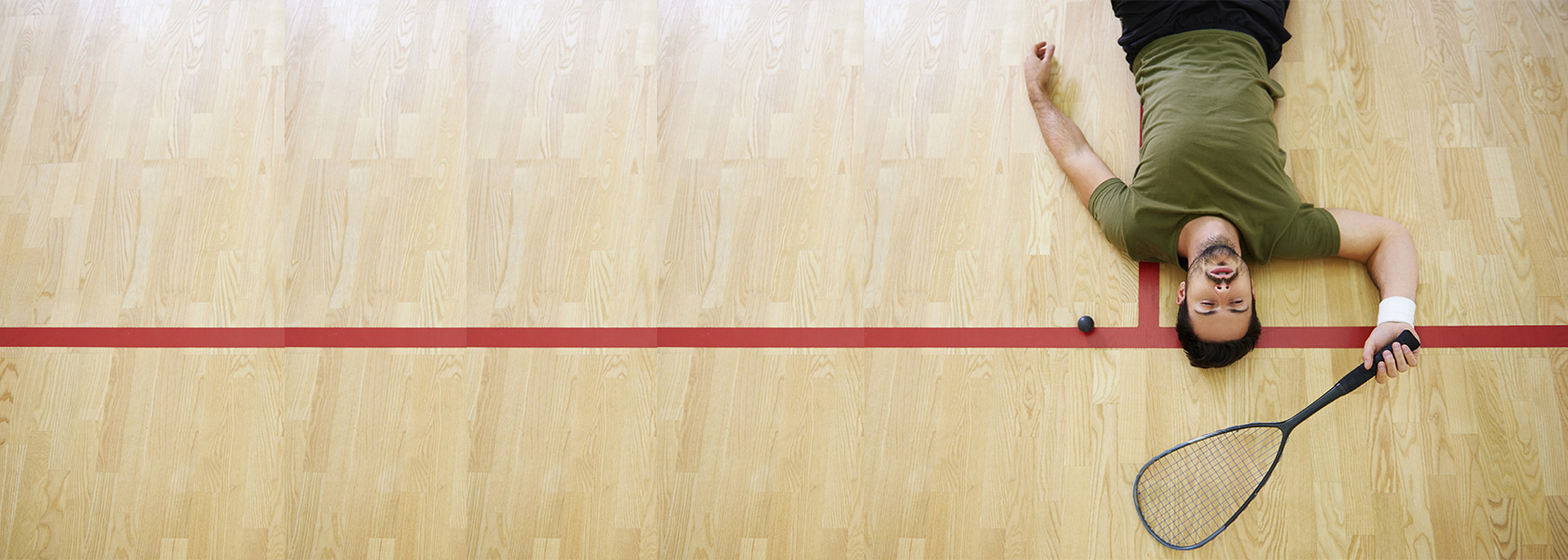
If you’ve ever been unfortunate to experience back pain while playing squash, you’ll know how off-putting and detrimental it is to your game – not to mention problematic in attempting everyday tasks for some days afterwards.
One of the most common complaints in squash is symptomatic back pain. Because this is a fast-paced game that demands quick sprints and much jumping and turning in a rather confined space, the potential for back injuries, strains, and stresses are immense.
Back pain is a niggling affliction and can make life a misery – especially when it messes with your squash playing! However, this is one ailment that many of us will simply shrug off, pop a few paracetamols, and just get on with it.
Yet, if you want to continue playing and enjoying squash and not seize up each time you step on and off the court, there are measures that you can take, regardless of whether you’re a newbie to the sport or an age-old pro.
Common Causes of Back Pain When Playing Squash
There are three common causes of back pain suffered by players during this game. These include those rapid movements throughout gameplay, slipping throughout gameplay, and even swooping down to reach the ball during your game of squash!
Slipping
When you move around a squash court, it’s fast-paced and swift. Couple this with the sweat of players and the squash court can make for a very slippery place indeed.
Thus, it’s little wonder that some players may find themselves slipping throughout the game. Thought the more experienced players may be able to react quickly to potential slipping incidents than those newer to the court, the possibility of injuring your back by slipping on a squash court is always something all players should be aware of.
Quick Sudden Movements
Squash is a game that naturally requires you to change direction rapidly, sprint, pivot, and suddenly stop. By doing this, your body is placed under immense pressure to conform in a quick time to be able to respond.
Ultimately this means you place your back joints and muscles under strain, which can, in turn, result in back pain through jarring.
Those experienced players have more of an understanding and will train themselves overtime to move their entire body as effectively as they possibly can to combat such sudden movements. Whereas beginners may find this needs working on. Yet, no matter what your squash level, changing direction and moving rapidly is a vital part of any squash game and is often not given much thought to – especially when your head really is in the zone!
Swopping Down Motions
In addition to quick movement and potential slipping, even the simple act of stooping down to reach lower ball returns can set off most back pain experienced when playing squash. This is perhaps the primary cause for most squash players of any level as this stooping motion can bring on an onset of back pain and injuries. This is especially so if you continue to stoop to pick the ball up each time without taking care of your positioning and remembering to bend your knees as you do so.
How Back Pain Often Presents Itself During a Game of Squash
The most common area for back pain through playing squash is usually the lower back area. However, this can manifest itself in several ways and isn’t just limited to a dull aching pain all over. You may also find symptoms here, including:
- A specific localised pain that often results in a loss of feeling in the legs or buttocks area
- Spasms in the back area
- Tenderness of the back muscles
- The onset of stiffness in the back
- The onset of sudden back pain once you stop moving for a few minutes
The Potential for Increased Problems Through Back Pain
Though most back pain that derives as a result of playing squash is treatable, if left unchecked, it can develop into something more serious.
Some players may find that if they don’t attend to their back pain and niggles, no matter how slight they may initially be, the potential for increased problems arises here, and can include:
- Numbness
- Pins and needles
- Weakness
- Reduced reflex action
- Difficulty when walking
Warming up Before Playing Squash Is Essential
Fortunately, there are many solutions that you can implement into your general squash playing sessions to work against combating potential back pain.
The most crucial aspect is warming up every time before you begin a competitive and fast-paced game of squash. Never skip this part, no matter what type of exercise or sport you’re taking part in.
Some people hate the warming up part of any sport and believe it a waste of time. However, as squash is one of the more intense ball games, this is perhaps the most important part of the process.
By warming up your body and stretching out carefully before your first game, you start off in the best condition and increase the amount of flexibility of your body when it comes to response time.
Ten minutes of light running, jogging, or simply moving around on the spot is ideal here alongside stretching before a match, in-between a match, and then after a match. Many squash players also like to play a gentle warm-up game and incorporate this as part of their warming up session.
Work Hard on Your Overall Fitness Levels
There’s no getting away from the fact that squash is fast-paced, and indeed a competitive sport which requires you to be in good physical shape to play. This means keeping those fitness levels at peak condition!
To stay in good condition and ensure your body is ready for that game each time you step onto the squash court, you should ideally be looking to take care of your body off the court also.
For best measures, it’s helpful to:
- Maintain a healthy and stable weight
- Keep your fitness and stamina levels up outside of playing squash
- Regularly stretch out those back and neck muscles
- Ensure you get a good amount of sleep
- Consider a couple of relaxation sessions, preferably after a game of squash also
Exercises to Help Keep Back Pain at Bay
Here we offer some basic but extremely beneficial exercises and stretches you can incorporate into your usual warming up routine to increase your chances of fighting off any back issues when playing squash. You can also refer to these during a break in the game and afterwards or whenever you feel the need to stretch out those essential back muscles.
Back Stretches
- Lying down on your back, place your hands head height
- Bend your knees by pulling them up towards your back
- Slowly begin to roll your knees to one side
- As you do so, keep your feet placed on the floor
- Hold this move for around ten seconds each time
- Repeat this procedure a couple of times on either side
Pelvic Tilts
- Lying down with your knees pulled up and bent, flatten your back in position against a wall
- Tighten your stomach muscles as you do so
- Hold this move for around five seconds each time
- Repeat this process for a couple of times on either side
Deep Lunges
- Kneeling on one knee, take the other foot and place it in front of you
- Facing forwards, lift your back knee up
- Hold this move for around five seconds
- Repeat this process for a couple of times on either side
One-Legged Stand
- Bending one leg up behind you, hold onto a surface for support
- Hold this move for around five seconds
- Repeat this process for a couple of times on each side
Recovery After a Game of Squash Is key
As essential as warming up is before playing squash, so too is the recovery time you allow your body after an intense game of squash.
Though not discussed as much in the forms as such, how you spend your recovery time after a squash match can play a huge part in determining whether you’re affected by back pain.
Because of the sheer intensity of squash, your body will need a chance to catch up and recuperate – as too will your mind!
For this reason, experts suggest that refreshing, replenishing, and reflecting is a crucial process of the comedown after every squash game. Therefore, to ensure you can fight off the process of back pain throughout your squash playing career, consider:
- Taking a cooling shower immediately after each game to get your body temperature back to its normal rate.
- Drinking and replenishing your body to keep it hydrated immediately after a game. A basic recovery shake here, such as chocolate milk, will do the trick!
- Most squash players come off a court hyped up, with the blood still pumping ferociously. Therefore, take this time to relax and calm down, allowing both body and mind to return to normal.
Ultimately, prevention is the key to ensure a healthy back when playing squash. Therefore, devote time to warming up correctly and be mindful of how you react when playing, alongside cooling down and recovering more efficiently. This way, you can work at keeping problematic back issues at bay throughout your squash playing sessions, therefore getting on with enjoying this fantastic sport in the process!


